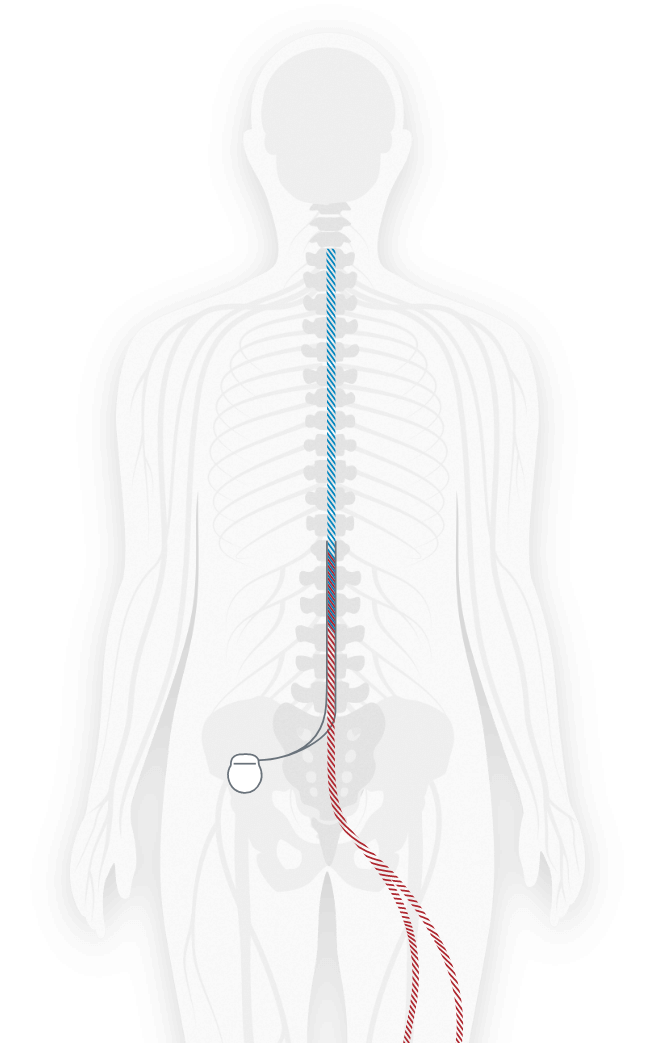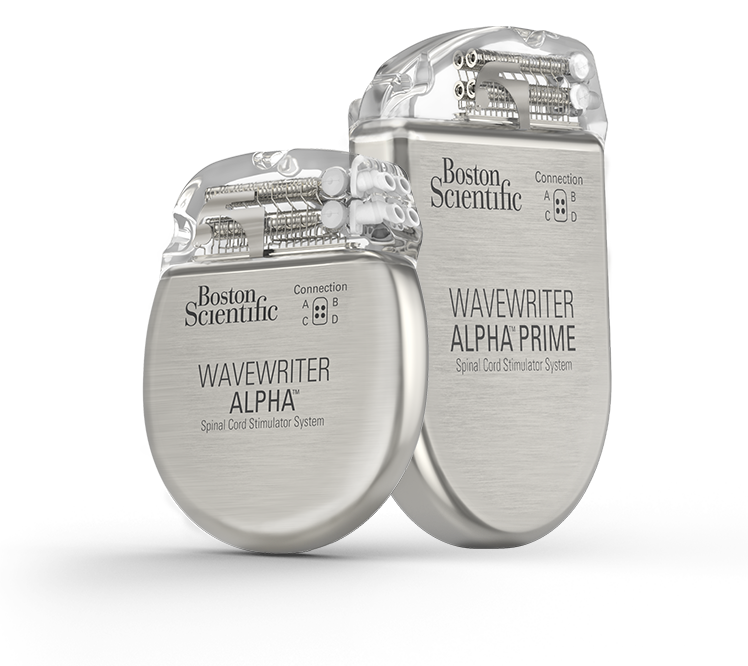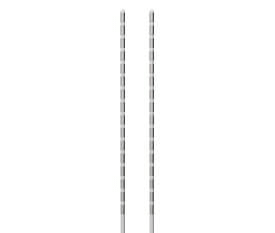How does SCS work?

You feel pain when nerves send pain signals through your spinal cord to your brain.
Your Spinal Cord Stimulation (SCS) System is designed to interrupt these signals so you don’t perceive them as pain.

You feel pain when nerves send pain signals through your spinal cord to your brain.
Your Spinal Cord Stimulation (SCS) System is designed to interrupt these signals so you don’t perceive them as pain.

Stimulator
A small device called a spinal cord stimulator is implanted under the skin.

Leads
Thin, flexible "leads" are connected to the spinal cord stimulator and placed along your spinal cord or into the subcutaneous tissue plane, near the targeted peripheral nerve(s).

Pulses
The spinal cord stimulator sends mild pulses through the leads to the nerves.

Pain
The pulses interrupt the pain signals on the way to the brain.
SCS therapy is used to treat different kinds of chronic pain – pain lasting six months or more. This can include pain in the back, legs, and feet, or a combination of different pain areas.
SCS systems are indicated for people with the following pain conditions, including but not limited to:
Consult your doctor regarding your specific pain area and therapy options.
There are different types of SCS therapies to help manage chronic pain.
Some therapies work by replacing your pain with a gentle tingling feeling, while others use a kind of stimulation you won’t feel at all.
With the WaveWriter Alpha SCS System, you and your doctor can choose the type of therapy that feels best for you — or even use both types together.
Boston Scientific’s SCS Systems are designed to deliver more than one kind of therapy at the same time in a single device. This flexibility means you may not need to switch devices if your pain changes over time. These therapy options have been clinically proven to provide greater relief from chronic pain.1
The WaveWriter Alpha SCS System features Boston Scientific’s non-tingling FAST Therapy. While other SCS Systems use therapies that may take days to “wash in”, FAST Therapy is designed to provide immediate relief to suitable patients. In a recent clinical study, patients using FAST Therapy went from an average pain score of 6.5 to an average of 1.3 in a matter of minutes.2
And, because FAST Therapy uses less energy than other forms of non-tingling therapy, it may help to reduce the amount of charging you have to do or may extend the life of a non-rechargeable system.3

Effectively managing your pain can help you get back to enjoying many of the little things in life you’ve missed. In a clinical study, patients using the Boston Scientific SCS therapy offered in the WaveWriter Alpha SCS System reported a great improvement in their ability to do everyday activities†.4
At a single trial site in the United Kingdom conducted over a 7.5 year period, more than 90% of the Boston Scientific trial participants reported a successful experience and opted to get a permanent implant.5
Lauren
I would say to anyone that’s considering Spinal Cord Stimulation, don’t be afraid to ask the question. A lot of people are afraid to ask for what they want and for what they need, but don’t be. Ask.
Chris
Pain is like a living thing. It can change in different ways…but so can your stimulator.
*Consult with your doctor if this therapy is right for you.
**MRI conditional when all conditions of use are met.
†As measured by the Oswestry Disability Index at 3 months and sustained out to 2 years post implant.
References:
The patient quotes in this material describe real personal experiences. Individual results may vary. Patients can experience different levels of pain management and different changes in their activities and use of medications. Consult with your physician to determine if you are a candidate for this procedure and what you may gain from the therapy.
Results from different clinical investigations are not directly comparable. Information provided for educational purposes only.
Results from clinical studies are not predictive of results in other studies. Results in other studies may vary.
Disclaimer and endnotes:
Results from case studies are not necessarily predictive of results in other cases. Results in other cases may vary.
All images are the property of Boston Scientific. All trademarks are the property of their respective owners.
Individual symptoms, situations, circumstances and results may vary. This quiz is meant for information purposes only, it is not intended to be used for medical diagnosis or treatment or as a substitute for professional medical advice. Please consult your doctor or qualified healthcare provider regarding your condition and appropriate medical treatment. This site is intended for Australian residents only. Please review the Boston Scientific Privacy Policy, for practices on the collection, storage, use and disclosure of your personal information.
Content of videos are for Information Purposes only and does not constitute medical advice. BSC strongly recommends that you consult with your physician on all matters pertaining to your health or to address any questions.
Talk to your healthcare professional about whether this product may be suitable for you as part of your overall plan to manage chronic pain. The WaveWriter Alpha System is not a first-line treatment for chronic intractable pain.
Surgery is required in order to use the WaveWriter Alpha System and any surgical procedure carries risk. Outcomes may vary for each patient. Patients should consult their healthcare professional about factors that could impact their response.
CAUTION: This product is not available for purchase by the general public. Indications, contraindications, warnings, and instructions for use can be found in the product labelling supplied with each device or at www.IFU-BSCI.com.
Australia and New Zealand: Boston Scientific Pty Ltd | PO Box 332 Botany NSW 1455 Australia